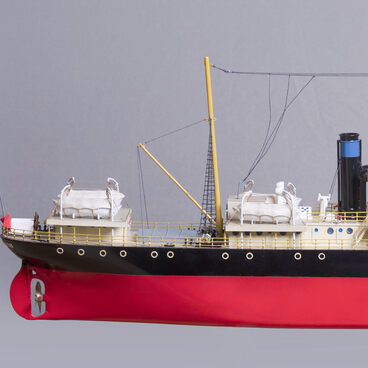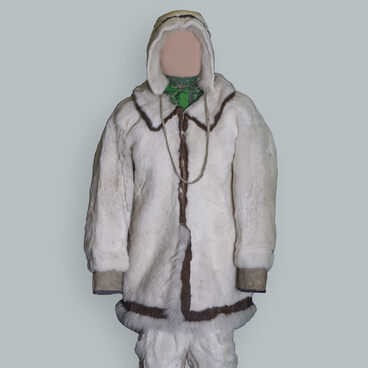Nganasans have long decorated their clothes with a geometric striped pattern called muli. Smaller than the Nenets one, it is made of leather and always had a symbolic meaning. Some of the patterns indicate a particular group: men, women, children, etc. Others have protective functions, they were used to surround other muli. Combinations of red, white, and black tones in clothing indicate a developed sense of color.
A festive or dancing outfit — tosodja lu— consists of two pieces of clothing (upper and lower shoulder) that are worn one on top of the other. They are made up of predominately white skins, and decoration plays an important role. The cut of the outfit is a two-part one: one part from the top to the waist and the other one — from the waist to the hem.
The back and the front parts are made from a single piece of a hide in which sleeve openings are cut; a gusset is sewn into the opening from a piece of deerskin suede dyed red.
A festive or dancing outfit — tosodja lu— consists of two pieces of clothing (upper and lower shoulder) that are worn one on top of the other. They are made up of predominately white skins, and decoration plays an important role. The cut of the outfit is a two-part one: one part from the top to the waist and the other one — from the waist to the hem.
The back and the front parts are made from a single piece of a hide in which sleeve openings are cut; a gusset is sewn into the opening from a piece of deerskin suede dyed red.
The sleeves are sewn using alternating stripes of dark and light fur.
The bib, made from three vertical fur stripes, is sewn separately and decorated with black and red cloth edging and ornamental stripes in mosaic technique in white and black leather. The back is made of separate pieces of a hide. The yoke, back, and sides of the hood are cut from a single piece. Along the rounded seam at the back of the hood, a stripe of dyed deerskin suede is sewn in; the two deerskin suede tassels at the base of the hood are connected by a strap.
Colored cloth edging is laid in the seams at the shoulders and in the seams connecting the horizontal stripes of the lower part of the body panel.
Between the moku (a quadrangular piece of fur on the back) and the shoulder yoke, an ornamental stripe with leather mosaic is sewn. Along the top line of the moku is a row of chandao pendants made of narrow, long deerskin suede stripes, with horizontal dashes in black and red paint on them.
The part of the garment below the waistband consists of three horizontally arranged and stitched together stripes made of young reindeer skin.
Along the hem, a red-painted stripe of deerskin is sewn on with the fur facing inwards. A white dog fur trim is sewn onto the stripe.
The lower, longer part of the parka is sewn from winter furs on the inside, embroidered with deer neck hair, and trimmed with white dog hair.
The ethnographer Galina Nikolaevna Gracheva points out the ornamentation and chandao as indicators of the gender, age, and family status of the owner, and the elongated center of the back — as a sign of festive clothing.
The bib, made from three vertical fur stripes, is sewn separately and decorated with black and red cloth edging and ornamental stripes in mosaic technique in white and black leather. The back is made of separate pieces of a hide. The yoke, back, and sides of the hood are cut from a single piece. Along the rounded seam at the back of the hood, a stripe of dyed deerskin suede is sewn in; the two deerskin suede tassels at the base of the hood are connected by a strap.
Colored cloth edging is laid in the seams at the shoulders and in the seams connecting the horizontal stripes of the lower part of the body panel.
Between the moku (a quadrangular piece of fur on the back) and the shoulder yoke, an ornamental stripe with leather mosaic is sewn. Along the top line of the moku is a row of chandao pendants made of narrow, long deerskin suede stripes, with horizontal dashes in black and red paint on them.
The part of the garment below the waistband consists of three horizontally arranged and stitched together stripes made of young reindeer skin.
Along the hem, a red-painted stripe of deerskin is sewn on with the fur facing inwards. A white dog fur trim is sewn onto the stripe.
The lower, longer part of the parka is sewn from winter furs on the inside, embroidered with deer neck hair, and trimmed with white dog hair.
The ethnographer Galina Nikolaevna Gracheva points out the ornamentation and chandao as indicators of the gender, age, and family status of the owner, and the elongated center of the back — as a sign of festive clothing.



